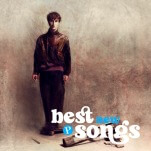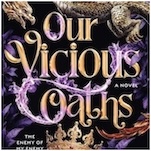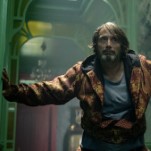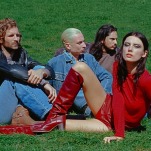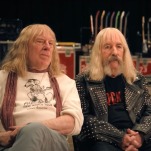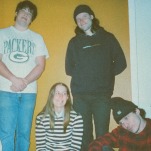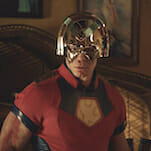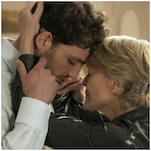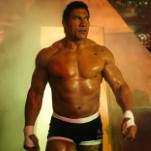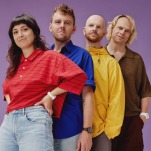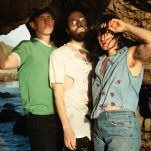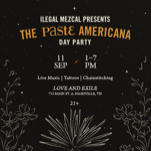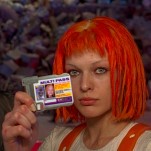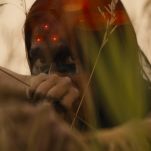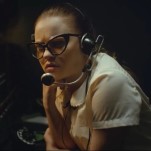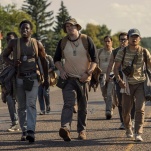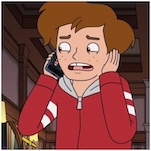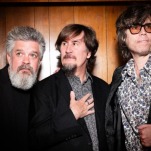In Season Two, AMC’s Preacher Tries to Conjure That Ol’ New Orleans Magic
Photos: Skip Bolen/AMC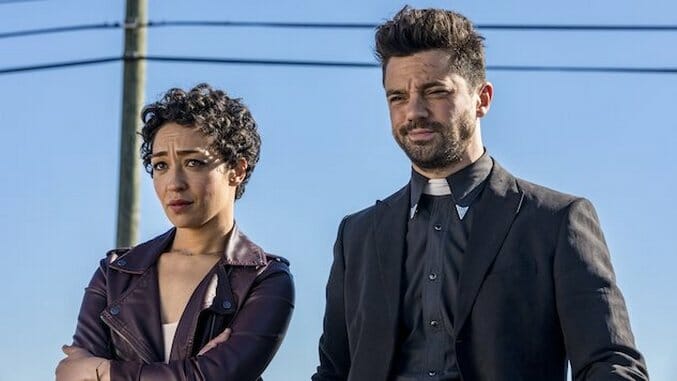
Joseph Gilgun, the lanky, loquacious Englishman of AMC’s Preacher—in which he plays Cassidy, a lanky, loquacious Irishman, er, vampire—switches subjects so often that his river of words threatens to jump its banks. He compares his career as an actor to his former one, as a builder: “No one ever came and brought you some shit for the sake of it.” He imitates Jeff Goldblum in Jurassic Park after an accidental allusion to the film’s mathematician, Ian Malcolm: “Inevitably, life finds a way to fuck things up.” He riffs on Star Wars, Father John Misty, life off the grid, marijuana, even the drab function hall in the New Orleans suburbs where we sit at a large, round table, as if unpopular cousins at a Southern wedding: “A lot of dreams have died in here.”
I am nonetheless caught flat-footed when he interrupts his thoughts on “Pure Comedy” to ask after my hasty scribbling—by force of habit, I take copious notes during interviews even when my recorder’s running, and after years as a film critic, compiling ideas in darkened movie theaters, I can do so without glancing at the page.
“Are you writing without actually writing?” he asks, warm peals of laughter shoved between sentences. “For a minute I was like, ‘Are you drawing dicks without looking down?’ That’s a dick; that’s another dick. Sweet. Twentieth dick of the day. That’s a terrible OCD: Gotta draw at least 20 dicks a day or me family will die.”
I mention it, of course, because it’s the rare moment of real color to come out of such interviews. But Gilgun’s freewheeling approach also echoes Preacher’s Season Two arc, which carries the main characters to New Orleans and toys with the city’s mythos in the process: debauched or cultured, decaying or vibrant, beautiful or obscene, depending on who you ask, and when. It’s a promising tack for the series, developed by showrunner Sam Catlin, Evan Goldberg and Seth Rogen from the comics by Garth Ennis and the late Steve Dillon, dovetailing with Preacher’s delicate balance—and, at times, lack thereof—among multiple genres. Our first sight of the city in Season Two, after all, is at once quintessential New Orleans and its very opposite: a tourist vomiting onto the surface of Bourbon Street, somewhere between Tropical Isle and Cat’s Meow.
“I’d been to New Orleans for maybe 24 hours, 20 years ago,” Catlin explains. “I didn’t realize Bourbon Street was like Times Square for New Yorkers… It just felt like the iconic first place to start.”
It’s not all bachelor parties and spring breakers, though. On the late April day I see Preacher in action, the cast and crew are on location at Richie Savoie’s New Orleans Audio Video, tucked in among a warren of strip malls and office parks 25 minutes upriver in Harahan, La. The nondescript setting is apt: Preacher’s foremost merit is its fraught relationship with convention, generating tension between expectations and execution, and admitting that New Orleans is more than its most familiar locales is, in its way, as surprising as a Season One’s relationship with the Western. (In one sequence from the series’ freshman run, for instance, a smash cut to scalped and disemboweled American Indians hanging from a tree belies a man’s description of America as “paradise”—returning to, and reinterpreting, one of the genre’s central themes.)
In essence, Season Two transports the characters to a road movie: Troubled holy man Jesse Custer (Dominic Cooper), the love of his life, Tulip (the blisteringly entertaining Ruth Negga), and his best friend, Cassidy, set out in search of God—the Big Man’s gone AWOL—pursued all the while by a supernatural bounty hunter known as the Saint of Killers (Graham McTavish). To those unfamiliar with the comics, myself included, the series can be hard to sink one’s teeth into, a witches’ brew of faith and doubt, violence and humor, historical referents and postmodern pastiche, but seeing it as an attempt to work through (as opposed to in) well-known genres has helped. In Season Two, New Orleans functions as both an emblem of the road movie’s expansiveness—shifting the action to a “cosmopolitan” city—and a twist on its fleet-footedness—each of the characters has a history here, threatening to ensnare them once more.
“Season One is very contained; it’s very much about a small-town preacher with small-town responsibilities,” Catlin says. “Season Two begins Jesse’s journey out into the wider world. And what could represent the wide-open world more than New Orleans does?”
McTavish, by contrast, describes the setting as “claustrophobic”: “You’re more contained, penned in,” even as the landscape offers opportunities to hide in plain sight. He recalls shooting a scene inside One-Eyed Jacks, a French Quarter music venue, and venturing outside in costume—.44 guns, cavalry sabre, duster coat, scraggly beard, “scary makeup”—only to find that passersby barely batted an eye. “Nobody paid me any mind at all,” he says. “I just blended right in.”
If there’s one through line in the cast’s reflections on New Orleans, it’s this notion—which, in the vein of most clichés, contains an element of truth—that the local affect is a certain world-weariness: “The Big Easy,” with its suggestion of the fun-loving and the laissez faire, and “The City That Care Forgot,” more rueful, resigned, are two sides of the same coin, one that Preacher’s second season attempts to roll on its knuckles. As Gilgun points out, for Cassidy in particular the setting is a potent reflection of personal struggle.
”[Everyone] seems to embrace decay out here,” he says. “They kind of make do. Just ‘cause some shit’s broke, that doesn’t mean you need to get this brand new plastic version in—you sort of repair. And I think, for Cassidy, being in a place like that—a guy who can’t decay, who’ll just do anything to fall apart and simply never does—that really changes the dynamic.”

Whether Preacher can sustain that dynamic without reducing it to stereotype remains to be seen—in the long annals of New Orleans-set films and TV series, stories that capture the complications of the place are vanishingly rare. (Even David Simon’s Treme, perhaps the most rigorous recent effort, is far from universally beloved by locals.) I keep coming back to that Bourbon Street sequence in the new season’s third episode, poised, much as the series itself, on a tonal knife’s edge. On the one hand, of course Jesse, Tulip and Cassidy spend their first night in town on Bourbon—I did, when I moved here eight years ago. On the other, the moment registers as a strange choice for a series so committed to its ironic inflection—one in which execution follows expectation, rather than upending it.
Despite the tedium of the day’s scenes, then—creative coverage of the same two conversations, run through again and again from multiple angles—it’s a relief to see Preacher outside the confines of the French Quarter. The series, with its heady combination of realism and fantasy, might indeed find that New Orleans is a perfect fit, willing to engage the city’s place in the popular imagination by wielding cliché, and its truth content—for both comic and dramatic effect. As Cooper remarks, undoing Custer’s collar in a side room at Richie Savoie’s, New Orleans rewards those disposed to dig beneath its surface.
“I’ve worked here before, for quite a while, and I’m seeing a very different side to it,” he says. “It’s a melting pot of so many different cultures from so many different places… It definitely gives it richness, and I hope we’re getting enough of it, just the beauty of it, of the landscape and the architecture. But you feel it in the air when you’re here.”
In this, Season Two is set to resume Preacher’s balancing act—between the road movie and its reinvention, between the characters’ outsized personalities and all-too-human dilemmas, between New Orleans as it’s described in fiction and New Orleans as it is. In the course of my day on location, I hear the same adjectives that have been used to define the city since its settlement nearly three centuries ago: “baroque, haunted, Gothic” (Catlin); “oppressive,” “macabre,” “Bacchanalian” (Negga); “a party town,” “visually stunning,” “falling apart” (Gilgun); “eccentric,” “artistic,” “everything” (Cooper). And yet, if there’s a series confident enough to undercut convention even as it employs it, it’s this one.
“Nothing surprises anybody here,” Negga says, as if she sees it as a gauntlet thrown. “That’s handy, doing Preacher.”
Season Two of Preacher premieres Sunday, June 25 at 10 p.m. on AMC.
Matt Brennan is the TV editor of Paste Magazine. He tweets about what he’s watching @thefilmgoer.


















